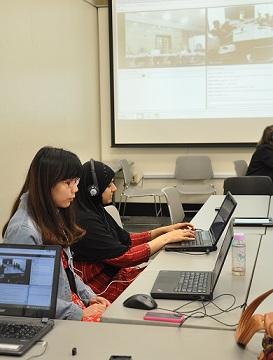This spring, a new urban planning course is narrowing a distance barrier that, for years, has hampered cross-continental, international study experiences. Industrial Districts, History, Theory and Practice is one of six innovative courses on campus this year to provide students a first person, interactive account of foreign cultures and economies. Developed by Dr. Marie Howland, UMD Professor of Urban Studies and Planning, and her longtime colleague, Professor Leonid Limonov of St. Petersburg’s Higher School of Economics, National Research University (HSE), the course is funded by a Global Classroom Initiative Grant from University of Maryland’s Office of International Affairs. The course pairs graduate students from the Urban Planning Program with students from St. Petersburg University’s Higher School of Economics to study and compare industrial policy in the U.S. and Russia.
Using industrial districts in both countries as case studies, students are examining the policies that drive their creation and the effectiveness of government incentives in job creation and local development. Students have studied the role of industrial clusters and agglomeration economies, to improve operation efficiency and gain a competitive edge. Using Adobe Connect, students meet weekly for a “virtual classroom” and again separately in blended, virtual teams, with typically one to two Americans and three to four Russians. Communicating through Skype, instant message and e-mail, the teams each developed a comparison study of industrial policies in the two countries and the influence of different histories, politics, and geographies.
“It’s been interesting to see how politics and economics shape the industrial landscapes of our two countries; it’s very different,” said Cole Green, a graduate student in the Urban Studies and Planning Program. “It’s a valuable learning experience, in that it lets us see if there is anything we can adapt, and vice-versa.”
The course is challenging in both subject matter and logistics. St. Petersburg is seven hours ahead of College Park; students also face cultural and language barriers and the occasional technological snafu, expected when you’re partnering exclusively through fiber optics and satellite. But, in preparing students for a highly globalized economy where there is so much to glean from international practice, the experience is essential.
“It’s a very different experience, but it’s where the profession is going,” said Marie Howland “There is so much to learn from our foreign counterparts, and this experience is much more valuable than anything I could teach in a textbook or lecture.”
The course complements an on-going study abroad studio in St. Petersburg that Dr. Howland has orchestrated for over 20 years. The most recent summer studio was a 2012 interdisciplinary study of the Gasholder’s Site in St. Petersburg. While Howland hopes to continue study abroad trips to Russia, the new global classroom provides opportunity for more frequent learning and collaboration.
“The global classroom provides a glimpse into the future of higher education,” said David Cronrath, Dean of the School of Architecture, Planning and Preservation, “one that is more innovative and collaborative, and that prioritizes experience.”

